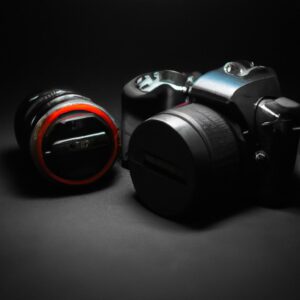Battle of the Cameras: DSLR vs Mirrorless

Introduction
In the world of digital photography, two of the most popular camera types are DSLR and Mirrorless Cameras. Both have their own unique advantages and disadvantages, and it can be hard to decide which one is right for you. That’s why we’ve created this guide to compare and contrast the features, prices, image qualities, sizes, portability, ergonomics, battery life, autofocus performance, durability, and more of these two camera types.
We’ll provide a comprehensive overview of each type of camera, as well as a comparison of how they match up in various categories. This way, by the end of the guide you can have an informed decision about which type of camera best suits your needs.
Overview of DSLR Cameras
Digital Single-Lens Reflex (DSLR) cameras are currently the most popular type of digital camera on the market, favored for their advanced image quality and range of interchangeable lenses. DSLRs offer a wide range of features including manual settings, fast shutter speeds, great low-light performance, and full HD video capabilities. These features make DSLRs ideal for both professionals and casual photographers.
The main advantages of DSLR cameras are their versatility and ability to capture high-quality images. DSLRs offer a variety of lenses to choose from, allowing you to get creative with your photography and experiment with different angles and perspectives. Additionally, DSLRs are renowned for their superior low-light performance and larger image sensors, which allow them to take advantage of more available light and capture more detailed images. Lastly, DSLRs have the fastest shutter speed of any digital camera type, allowing you to capture split-second moments with ease.
The drawbacks of DSLR cameras mainly come down to size and weight. DSLRs are bigger and bulkier than other types of cameras, making them harder to carry around and less ideal for travel photography. Additionally, the multitude of lens options and manual settings can be intimidating for beginners, making it difficult to get the most out of your camera without prior experience.
Overview of Mirrorless Cameras
Mirrorless cameras are becoming increasingly popular due to their size, weight, and image quality. As the name implies, these cameras do not feature a mirror like traditional DSLRs, which means they are smaller and lighter. Despite this, mirrorless cameras can still capture stunning images with the right equipment.
One of the main advantages of mirrorless cameras is their portability, as they are much smaller and lighter than DSLRs. This makes them ideal for travel or other situations where size and weight matter. Additionally, mirrorless cameras come with a variety of lenses to suit different needs, from wide-angle to telephoto lenses.
In terms of image quality, mirrorless cameras can produce excellent photos on par with DSLRs. The main difference is that they can be more difficult to use in lower light conditions due to the lack of a mirror and the resulting shallow depth of field. However, with the right lenses and settings, mirrorless cameras can still produce amazing photos.
One of the biggest advantages of mirrorless cameras is their autofocus performance. These cameras feature advanced autofocus systems that can track a subject’s movement quickly and accurately. This makes it easier to capture sharp, blur-free images that would otherwise be difficult to achieve.
Finally, mirrorless cameras are also more durable than DSLRs. These cameras are usually built with tough materials like magnesium alloy and rubber seals to ensure they can withstand the elements. This makes them well-suited for outdoor use and other challenging environments.
Overall, mirrorless cameras are a great option for photographers who need portability without sacrificing image quality. With the right lenses and settings, these cameras can produce stunning results.
Comparison of Price Range
When it comes to comparing DSLR vs. Mirrorless cameras, price is an important factor. The average price of a DSLR camera can range anywhere from around $500 up to $3,000 or more for a higher-end model. On the other hand, the average price of mirrorless cameras generally ranges from $400 to $2,000.
For those on a budget, a basic DSLR with a few lenses can be found for around $500. For those looking for the highest quality image and greatest performance, a DSLR kit may cost closer to $2,000-$3,000. Mirrorless cameras typically provide great value for money, with a wide range of models available for under $1,000. In addition, mirrorless cameras often have smaller and lighter body styles, making them more portable than DSLRs.
When comparing prices between DSLR and Mirrorless cameras, it’s important to consider the type of photography you plan to do. If your primary purpose is to take professional-level photos, then a higher-end DSLR camera would likely be the better choice. For casual photography and videography, a basic Mirrorless camera could provide great value.
It’s also important to note that prices can vary greatly between different brands and models, so it’s worth researching different cameras to find the best value. Online stores like Amazon and B&H Photo usually offer competitive prices and often provide discounts and promo codes for additional savings.
Comparison by Image Quality
When comparing DSLR and mirrorless cameras, image quality is one of the most important factors to consider. DSLRs are typically known for their excellent image quality, allowing for better color accuracy and more natural looking images.
Mirrorless cameras are also capable of delivering high-quality images but they generally lack the same level of detail that a DSLR can produce. Both camera types come with a variety of features to help improve image quality, such as adjustable ISO settings and RAW image capture.
Another key difference in image quality between DSLRs and mirrorless cameras is the type of lens used. DSLRs usually offer a greater variety of lenses, allowing for more specialized shots. Mirrorless cameras, on the other hand, usually have fewer lens options, limiting the range of photos possible.
Depending on the intended usage, either of these camera types could be a better fit for a given photographer. DSLRs are often preferred by serious photographers who value image quality over portability. Mirrorless cameras, however, offer a good balance of image quality and convenience – making them ideal for casual photographers who don’t need the highest quality images.
Comparison of Size & Portability
When it comes to size and portability, there is a clear difference between DSLR Cameras and Mirrorless Cameras. DSLR cameras are larger and, due to their removable lenses, they often require multiple bags or cases to carry around. Mirrorless cameras tend to be much smaller, since their lenses stay attached, allowing them to fit inside most backpacks. This makes them ideal for travel, where carrying bulky equipment might be a hassle.
If portability is a priority, mirrorless cameras are the way to go. Their smaller form factor also allows for shooting in tight spaces, more easily fitting into any environment you may encounter. DSLR cameras are still very capable and will give you higher image quality, but their size can be limiting at times.
Ultimately, the decision should be based on which you find easier to handle and transport. Mirrorless cameras are great for photographers who need a lightweight setup but still want good image quality. However, if you don’t need to move around too much, DSLR cameras certainly have their advantages in terms of image quality and overall performance.
Comparison by Ergonomics
When comparing DSLR vs. Mirrorless cameras, the ergonomics of each type should be considered. Ergonomics refer to the comfort and ease-of-use when handling a camera. DSLR cameras typically have a more established design which may be easier to manage if you plan on using them for extended periods of time. Mirrorless cameras, on the other hand, usually have more compact designs which can make them more comfortable to carry and use in tight spaces or on trips.
Another important factor to consider is the layout and button placement. While DSLRs tend to have more physical buttons and dials, these can be more confusing and harder to get used to. Mirrorless cameras, however, often feature touchscreens which can make navigating the settings simpler and more intuitive. Additionally, DSLRs have fixed viewfinders, whereas many mirrorless cameras offer removable viewfinders which can be switched out for different lenses depending on the shooting situation.
Overall, both cameras offer great ergonomic qualities; it just depends on what the user is looking for. For those who prefer a classic approach, a DSLR is probably the better option. But for those who want something more up-to-date and efficient, then a mirrorless camera might be more suitable.
Comparing Battery Life
When it comes to comparing DSLR and Mirrorless Cameras, battery life is an important factor to consider. DSLR cameras typically have more powerful batteries than mirrorless cameras do, and these cameras are often able to take hundreds of photos on a single charge. On the other hand, mirrorless cameras usually have smaller, less powerful batteries, and their battery life can be limited to a maximum of around 300 shots at one time.
The difference in battery life between the two types of cameras can play a significant role when it comes to deciding which one to purchase. If you plan on taking lots of photos or videos in one go, then a DSLR camera may be the right option for you as its battery will be able to handle the strain much better. On the other hand, if you only plan on taking a few shots here and there, then a mirrorless camera should be suitable for your needs as its battery life can last a fairly decent amount of time.
Overall, when considering the battery life of DSLR and Mirrorless cameras, it’s important to think about how you plan on using the camera and what kind of workload it will be put under.
Comparison of Autofocus Performance
When looking at the choice between DSLR and Mirrorless cameras, autofocus performance can be an important factor to consider. While both types of cameras offer an autofocus feature, they differ in how quickly and accurately they can lock focus on a subject.
DSLR Cameras
DSLR cameras tend to have faster and more reliable autofocus systems. This is because most DSLRs are equipped with phase-detection autofocus which uses sensors to determine the distance between the camera and the subject for precise focusing. This makes them well suited for sports and wildlife photography where tracking fast moving objects is necessary.
Mirrorless Cameras
Mirrorless cameras, on the other hand, use contrast-detection autofocus which works by analyzing the image data from the sensor to detect areas of high contrast. While this method is less accurate and slower than its phase-detection counterpart, modern mirrorless cameras have been able to improve on their autofocus performance by using advanced algorithms to better identify subjects.
Conclusion
Ultimately, when it comes to autofocus performance, DSLRs may have an edge over mirrorless cameras due to their more reliable and faster focusing speed. However, with continued technological advancements, mirrorless cameras are also becoming increasingly capable of producing excellent results.
Comparison by Durability
When it comes to durability, both DSLR and mirrorless cameras have their own merits. Both are designed to be durable enough to withstand a range of environmental conditions, such as water, dust, and even extreme temperatures. However, when it comes to which is more likely to withstand wear and tear, here are a few things to consider.
DSLR Cameras
DSLR cameras are generally more robust than their mirrorless counterparts, making them better suited for challenging circumstances such as outdoor or action photography. They typically feature thicker, heavier bodies with more robust internal components, allowing them to survive the inevitable knocks and bumps that come with regular use. Additionally, they have more robust dust and weather sealing, making them better able to cope with inclement weather.
Mirrorless Cameras
While mirrorless cameras are usually lighter and more compact than DSLRs, they are still fairly durable. They have fewer moving parts than DSLRs, ensuring that there are fewer points of failure. Additionally, many mirrorless cameras feature weather sealing, meaning that they can cope well with rain, snow, and other adverse conditions.
Conclusion
Although both types of camera are designed to be durable, DSLR cameras tend to be the more robust option. They typically feature thicker, heavier bodies with more robust internal components, allowing them to survive the inevitable knocks and bumps that come with regular use. Additionally, DSLRs tend to have superior weather sealing, making them better able to cope with inclement weather. On the other hand, mirrorless cameras have fewer moving parts and are usually lighter and more compact, making them ideal for packed-up situations.
When it comes to choosing the best camera for you, DSLR and Mirrorless Cameras each have their own unique strengths and weaknesses. The decision can be difficult, since both cameras have vast differences in price, size, image quality, battery life, autofocus performance and more. After comparing the two camera types, it is still hard to pick an overall winner – as the right choice will depend on your individual needs.
For those looking for the highest level of image quality, DSLRs may be the better choice. These cameras have been the industry standard for years, and they still offer the best autofocus performance. However, they tend to be large and bulky, making them less portable than mirrorless cameras.
Mirrorless cameras are the newer type of camera on the block. They provide excellent image quality, but don’t quite reach the same level as a DSLR. They have become incredibly popular for their compact size, lightweight design, and long battery life. For those who like to take their cameras on the go, mirrorless cameras are an ideal choice.
Ultimately, the decision on which type of camera to choose depends on your individual needs and preferences. DSLR cameras offer superior performance and image quality, but may not be as portable as mirrorless models. On the other hand, mirrorless cameras are smaller and offer great portability, but may not have the same image quality or autofocus performance of DSLRs. Weigh the pros and cons of each camera type before making your purchase, so that you can find the right fit for your photography needs.
Resources & Credits
When researching this guide, we have used several sources of information. These include reviews from photography professionals and magazines, manufacturers websites and user forums. We would like to thank all the people who contributed to this comparison by providing us with valuable input.
Thanks to Jeff Tinkers for the images used in this guide. Special thanks to Scott Glade for the video comparison between DSLR and Mirrorless cameras that was included in the guide.
For further reading, we recommend Digital Photography Review, PetaPixel, and Imaging Resource. All of these websites provide detailed reviews on cameras and other photography-related topics.
comments: 0





